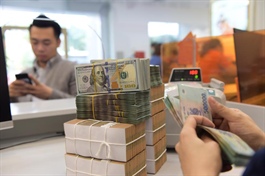The impressive 20-year development journey of VBSP
The impressive 20-year development journey of VBSP
Founded on October 4, 2002, the past 20 years has marked a successful development journey for the Vietnam Bank for Social Policies (VBSP) whose work has played a significant role in turning Vietnam into a bright spot in the global implementation of the millennium development goals on poverty reduction.

According to recent VBSP figures, in the past two decades, over 42 million households have taken loans valued at a total of more than $35.39 billion through the VBSP system.
The bank’s policy credit sources have contributed to driving the ratio of poor households in 2011-2015 from 14.2 per cent to a mere 4.25 per cent, and the ratio of multi-dimensional poor households down from 9.88 per cent in 2016 to just 2.75 per cent by 2020.
These efforts have contributed to turning Vietnam into a bright spot for the millennium development goals on poverty reduction, as recognised on a global scale.
From two credit programmes initially, VBSP has been and are expediting 22 credit programmes extensively across towns, wards and communes nationwide, helping needy households and other beneficiaries to secure a more stable life with constantly improved living standards.
Initially, in early 2002, poor households accounted for nearly 30 per cent of total family households nationwide. VBSP’s service scale mostly covered areas with special difficult conditions for development with underdeveloped infrastructure.
VBSP’s operation has not been easy, having to deal with mountainous communes, which are barely accessible by car, as well as the different cultures of 54 ethnic minorities groups with deeply-rooted self-sufficiency.
In many localities, VBSP’s credit staff have become piloting forces to set footholds in rural and remote areas, sharing efforts with border soldiers and local governments to aid local people in doing business, and from there reducing poverty.
To propel sustainable poverty reduction, the whole VBSP system has been focused on job creation and student lending, besides multiple credit programmes for enhancing life quality.
Stories about bringing policy credit to mountainous areas, or to delta locations helping local people to get rid of poverty have become commonplace, leaving an indelible mark on VBSP’s 20-year development journey.
During the whole process, not a single VBSP employee has left their job due to the hard work. Not only that, in 2021 when the pandemic broke out the country, many VBSP employees were sent to southern locations for support activities and willingly stayed there for nearly a year.
Notably, in the face of vigorous economic development since Vietnam officially opened its door to the world from 2007 and to reach the target of not leaving anyone behind and shortening the gap in incomes and development between the poor and more-successful, the government has raised poor household standards five-fold, along with enlarging the number of policy beneficiaries, striving for sustainable poverty reduction, and facilitating economic development and integration.
Amid ever-increasing responsibilities, VBSP not only handles the role as the government’s ‘extended hand’ in expediting social credit policies, but also acting as a bridge between needy and underprivileged people with government agencies, along with making proposals and consultation for the enactment of fresh credit programmes.
VBSP has also gradually raised the lending limit to meet actual development needs to support people more effectively.
Mounting challenges, however, persist on the path ahead for poverty reduction goal as inequality in income distribution remains high in the midland and northern highland regions, which also reports the highest ratio of poor households at 13.4 per cent.
To propel sustainable poverty reduction, the whole VBSP system has been focusing on job creation and student lending, besides multiple credit programmes for enhancing life quality.
These are the driving forces for successful implementation of national target programmes on sustainable poverty reduction and building a new-style countryside, and underpinning the country’s fast and sustainable development, striving to open up a spot among high-income nations by 2045.


























